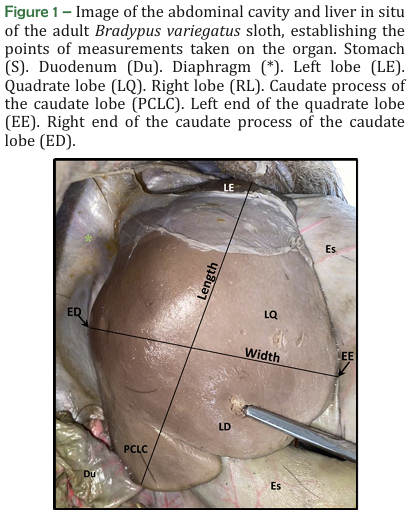Anatomical aspects of the liver and angiorchitecture of the hepatic portal vein of Bradypus variegatus SCHINZ, 1825 (MAMMALIA: PILOSA)
DOI:
https://doi.org/10.21708/avb.2025.19.1.12527Resumo
Sloths are placental mammals known for their slow movements and peculiar morphophysiological characteristics that need to be elucidated. In this context, the present study aimed to describe the morphological aspects of the liver and the distribution of the hepatic vein of Bradypus variegatus. Eleven animals were used for angiotechniques and dissections to describe the lobes, morphometry, and topography of the liver, as well as the vascular arrangement of the hepatic portal vein. Of the eleven, four specimens were dissected and used for specific morphometric analyses. Meanwhile, six animals were used for an angiotechnique with stained latex and one was used for an angiotechnique with stained vinylite and corrosion in 33% hydrochloric acid (HCL). The results indicated that the liver of B. variegatus is located in the cranial portion of the abdominal cavity, situated entirely in the right antimere, positioned cranially between the 7th and 9th ribs, and caudally between the 12th and 14th ribs. The organ has measurements directly related to the size of the individual, with the length representing approximately 18.8% of the animal's length. The liver has the following lobar divisions: left, quadrate, right, and caudate lobes, with caudate and papillary processes. Falciform, triangular, round, venous, hepatoduodenal, and hepatogastric ligaments were also evidenced. When dissecting the liver parenchyma, it was found that the hepatic portal vein emits two main branches, one right and one left, and these are distributed between the lobes, so that the left branch has a larger area of privacy than the right.
Downloads

Downloads
Publicado
Edição
Seção
Licença
Copyright (c) 2025 Acta Veterinaria Brasilica

Este trabalho está licenciado sob uma licença Creative Commons Attribution 4.0 International License.
Autores que publicam na Acta Veterinaria Brasilica concordam com os seguintes termos: a) Autores mantém os direitos autorais e concedem à revista o direito de primeira publicação, com o trabalho simultaneamente licenciado sob a Licença Creative Commons Attribution que permite o compartilhamento do trabalho com reconhecimento da autoria e publicação inicial nesta revista. b) Autores têm autorização para assumir contratos adicionais separadamente, para distribuição não-exclusiva da versão do trabalho publicada nesta revista (ex.: publicar em repositório institucional ou como capítulo de livro), com reconhecimento de autoria e publicação inicial nesta revista. c) Autores têm permissão e são estimulados a publicar e distribuir seu trabalho online (ex.: em repositórios institucionais ou na sua página pessoal) a qualquer ponto antes ou durante o processo editorial, já que isso pode gerar alterações produtivas, bem como aumentar o impacto e a citação do trabalho publicado (Veja O Efeito do Acesso Livre).


 Esta obra está licenciada com uma Licença
Esta obra está licenciada com uma Licença 